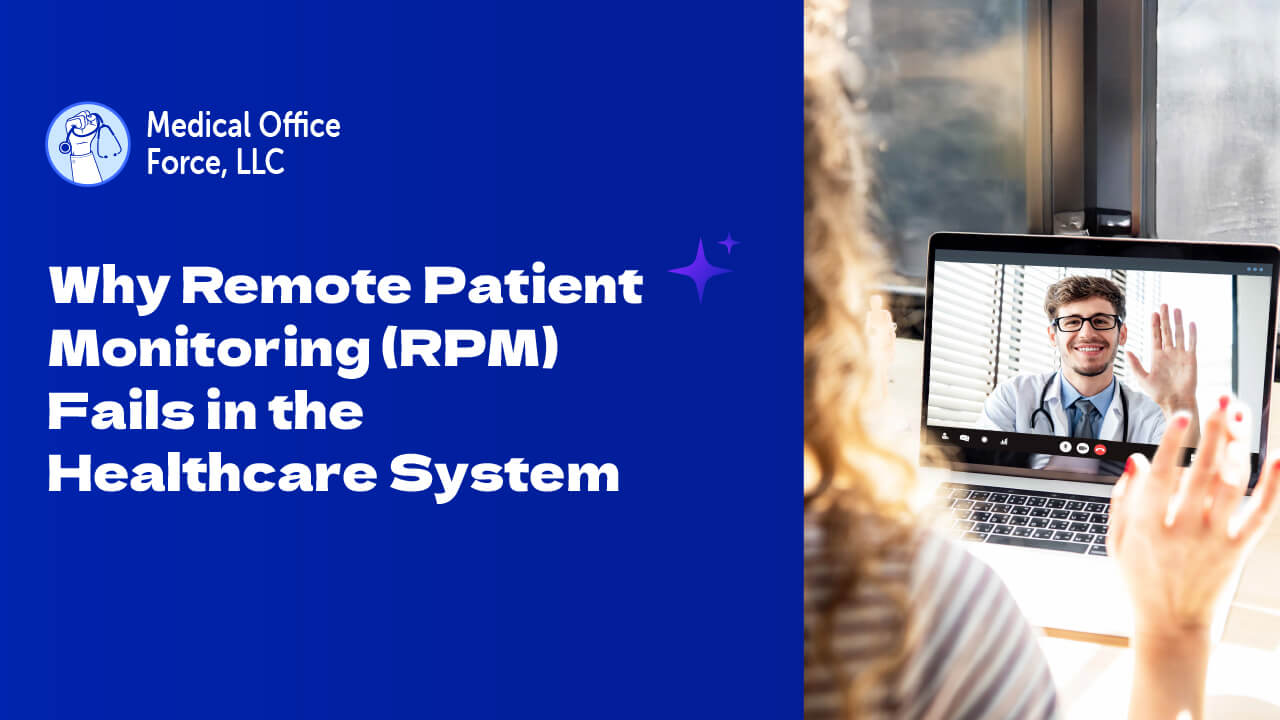
Why Remote Patient Monitoring (RPM) Fails in the Healthcare System
Remote Patient Monitoring (RPM) holds incredible promise for improving healthcare outcomes. It can help doctors manage chronic conditions, reduce hospital visits, and offer personalized care from a distance. The Centers for Medicare & Medicaid Services (CMS) even created billing codes to encourage its use. Yet, despite all this support, many RPM programs fail, or never reach their full potential.
Why is that?
In this blog, we’ll explore the common reasons why RPM fails in the healthcare system, and what practices can do to avoid these pitfalls.
What is RPM?
Remote Patient Monitoring is a form of telehealth that allows healthcare providers to track patients’ health data, like blood pressure, glucose levels, weight, or oxygen saturation, from home using digital devices. This data is then shared with providers through secure systems, allowing for timely interventions and better chronic care management.
If you’re new to RPM, check out our post on why RPM leads the future of healthcare to understand its growing importance.
CMS began reimbursing RPM services in 2019 with the introduction of CPT codes such as:
- 99453 (initial setup and patient education)
- 99454 (supply of devices and data collection)
- 99457 and 99458 (time spent on data review and patient interaction)
Despite these advancements, many RPM programs still struggle.
Your RPM Program Doesn’t Have to Fail
Many healthcare practices find it difficult to get RPM off the ground—whether due to tech challenges, staffing, or reimbursement confusion. That’s why we offer dedicated Remote Patient Monitoring (RPM) services tailored to clinics just like yours, helping you launch and sustain an effective, compliant program.
Now, let’s break down the most common reasons RPM efforts fall short—and how to avoid them.

1. Patients Aren’t Using the Devices Consistently
One of the biggest reasons RPM fails is simple: patients stop using the devices.
Why does this happen?
- Devices may be too difficult to use, especially for older adults.
- There is little to no follow-up from care teams to ensure continued use.
- Patients don’t understand how RPM helps them, so they lose interest.
What can be done?
Providers need to offer strong onboarding support, including live demos and easy-to-follow instructions. Regular check-ins can help boost adherence. Patients must feel like their data is making a difference.
2. Lack of Staff Training and Workflow Support
RPM can’t succeed without clinical staff who know how to use it. Many practices add RPM services without proper planning.
Common issues:
- Staff are unclear on roles, who reviews the data, who calls the patient, and how often?
- No one tracks time spent on RPM tasks, leading to missed reimbursements.
- Data gets lost in emails or spreadsheets instead of flowing into the EHR.
Government relevance:
CMS mandates clear documentation for RPM billing. If staff aren’t trained on these guidelines, practices risk audits, denials, or non-compliance.
Solution:
Every clinic offering RPM should have a clear workflow in place, define responsibilities, and train all involved staff regularly.

3. Technology Problems and Poor Connectivity
Many RPM solutions fail due to unreliable devices, poor integration with medical records, or internet issues.
Common problems include:
- Devices not syncing data correctly.
- Platforms not integrating with electronic health records (EHRs).
- Patients living in rural or low-income areas without stable internet access.
Government angle:
The Federal Communications Commission (FCC) has acknowledged the digital divide in healthcare. They fund initiatives like the Rural Health Care Program, but progress is slow.
What to do:
Choose devices with strong technical support and a track record of reliability. Make sure the platform is HIPAA-compliant and EHR-compatible.
4. Confusion Around Billing and Documentation
While CMS has provided RPM billing codes, many providers still don’t use them correctly, or at all.
Issues include:
- Not meeting the 20-minute time requirement for 99457/99458.
- Missing documentation for device delivery or patient interaction.
- Failing to differentiate RPM from other telehealth services.
What CMS says:
CMS requires specific criteria for billing RPM services, including patient consent, device use for at least 16 days/month, and time-tracking logs.
Fix:
Use software that automatically tracks time spent on patient care and generates reports for billing. Partner with third-party billing experts if needed.
5. Lack of Reimbursement Knowledge for Medicare Advantage and Medicaid
While traditional Medicare covers RPM fairly well, rules vary for Medicare Advantage plans and state Medicaid programs.
Challenge:
- Not all payers reimburse RPM the same way.
- Practices assume all patients are covered, then face denials.
Example:
Some state Medicaid programs cover RPM only for specific conditions (like diabetes or hypertension), and some not at all.
Solution:
Verify benefits before starting RPM with a patient. Use clearinghouses or revenue cycle management tools to identify covered services.

6. Offering RPM to the Wrong Patient Populations
RPM works best for patients with chronic conditions, who require frequent monitoring.
Common mistake:
- Offering RPM to young, healthy patients who don’t need ongoing tracking.
- Not focusing on Medicare patients with chronic conditions, who are most likely to benefit and be covered.
CMS guidance:
Medicare’s Chronic Care Management (CCM) and RPM programs are designed to work hand-in-hand for patients with two or more chronic conditions.
Best practice:
Use data to identify your ideal RPM patients, those with high risk, frequent ER visits, or poorly managed chronic diseases.
7. Poor Communication with Patients
Even if everything else works well, RPM fails when communication breaks down.
How?
- Patients don’t know what the readings mean.
- They never hear from a provider after sending in their data.
- They don’t feel engaged in their own care.
The result?
Patients stop using the device, or worse, they feel neglected and lose trust.
Fix:
Build RPM into your care model, not as a side program. Ensure patients receive feedback and feel part of their care team.
8. Compliance and Privacy Concerns
HIPAA compliance is a non-negotiable part of any healthcare technology.
Problems arise when:
- RPM devices are not encrypted or properly secured.
- Data is stored or transmitted without proper protections.
Why it matters:
A HIPAA breach can cost millions in fines and damage patient trust permanently.
What to do:
Work only with vendors who understand healthcare compliance. Make sure all systems are HIPAA-certified and security-tested.
How Medical Office Force Can Help
At Medical Office Force, we understand the unique challenges practices face with RPM. Our expert back-office teams can help you:
1. Identify ideal patients for RPM.
2. Manage device setup and tracking.
3. Ensure proper documentation for billing.
4. Navigate Medicare and Medicaid coverage rules.
5. Train your staff and integrate RPM into your workflows.
With the right support, RPM can be a powerful tool for better care—and better revenue.
Conclusion
RPM doesn’t fail because the idea is flawed. It fails because practices lack the resources, planning, and education to implement it correctly. With proper workflows, trained staff, engaged patients, and support from partners like Medical Office Force, your RPM program can thrive.
If you’re ready to take your RPM program to the next level, or you’re just getting started, reach out to us today.


For more information, write to contact@medicalofficeforce.com
Share Your Thoughts
No comments yet — be the first to comment!